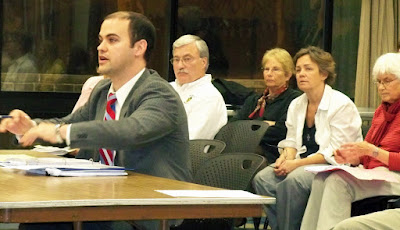 Maria Geryk (far left) Amherst Regional School Committee to her left
Maria Geryk (far left) Amherst Regional School Committee to her leftLast night the Amherst Regional School Committee (representing Amherst, Leverett, Pelham and Shutesbury) heard a polished presentation from a small group of High School students concerning the Minority Student Achievement Network conference they attended in Columbia, Missouri courtesy of Maria Geryk, who found the money in her Superintendent's budget to cover costs.
The well dressed, polite students apprised the committee of their "action plan" to give back to the system they had learned to negotiate (some of them the hard way) and actually thrive, by becoming mentors to Middle School kids--teaching by example the benefits of hard work, discipline and family teamwork.
Proud parents swelled the audience demonstrating how invaluable family involvement is to academic success.
When asked what style of teaching worked best: challenging or coddling, a young woman responded in favor of the former. Another young man articulated how poverty plays an important role in disrupting education, something parental oversight helps to overcome.
Committee Member Steve Rivkin picked up on the benefits of
higher expectations, even for poorer kids, by bringing up the $16,413 average student cost of education in Amherst--not known for a tough disciplinarian style-- compared to state average ($13,052), with relatively modest test scores to show for it.
Math results were particularly disappointing--especially among low income students.
He also criticized the deteriorated physical condition of Wildwood and Fort River elementary schools, calling them "substandard," while floating the idea of temporarily moving more grades (5-8 rather than current 7-8) into the underpopulated Middle School so renovations could occur at those older, less inviting schools.
Human Resource Director Kathy Mazur gave a brief presentation on Regional enrollment
projections for the next five years showing a steady decline from the current 1,592 in 2011-12 year to 1,425 in 2016-17. The Regional school system enrollment peaked in 2001-02 with 1,668 total students.
 Steve Rivkin
Steve RivkinThis dark drizzly evening, the Amherst schools hosted an Open House. Crocker Farm Elementary School, where my daughters attend, was packed with staff, students and parents. Maybe one reason Crocker Farm tested better than state average in math.









































